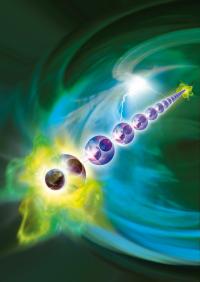SCIENCE
Exotic quantum states: A new research approach
Theoretical physicists of the University of Innsbruck have formulated a new concept to engineer exotic, so-called topological states of matter in quantum mechanical many-body systems. They linked concepts of quantum optics and condensed matter physics and show a direction to build a quantum computer which is immune against perturbations. The scientists have published their work in the journal Nature Physics.

Three years ago a research team led by Sebastian Diehl and Peter Zoller presented a completely new approach to engineer quantum states in many-body systems. They used a physical phenomenon that normally increases the degree of disorder in a system dramatically: dissipation. In classical physics dissipation is the concept that explains the production of heat through friction. Surprisingly, in quantum physics dissipation can also lead to order and a completely pure many-body state can be realized. This spring an Innsbruck research team, led by experimental physicist Rainer Blatt, demonstrated experimentally that by using dissipation certain quantum effects can be generated and intensified. By linking concepts of quantum optics and condensed matter physics, theoretical physicists from the Institute of Theoretical Physics of the University of Innsbruck and the Institute for Quantum Optics and Quantum Information of the Austrian Academy of Sciences have now pointed out a new direction of how dissipation may be used in another beneficial and promising way.
Immune against perturbations
 This is Sebastian Diehl of the Institute for Theoretical Physics, University of Innsbruck. | ||||
In condensed matter physics a new concept to describe order in many-body systems has gained in importance recently: topological order. Two examples for topological phenomena are the quantum Hall effect, which was demonstrated in the 1980s, and the topological insulator, which behaves as an electrical insulator in its interior while permitting the transport of charges on its surface. Sebastian Diehl and Peter Zoller's team of theoretical physicists now suggest realizing dissipation induced Majorana fermions in a quantum system. This topological phenomenon was named after the Italian physicist Ettore Majorana and describes particles that are their own anti-particles. "We show a new way of how Majorana fermions may be created in a controlled way in a quantum system," explains Sebastian Diehl. "For this purpose we use a dissipative dynamic that drives the system into this state in a targeted way and compels it back when affected by disturbances." With this new approach Diehl and his team combine the advantages of dissipation and topological order - both concepts are highly robust against perturbations such as disorder. Therefore, their suggestion to create Majorana fermions in an atomic quantum wire is of high interest for experimental implementation. It may be used for building a quantum computer whose basic building blocks consist of Majorana fermions. In quantum wires atoms are confined to one-dimensional structures by optical lattices which are generated by laser beams: Majorana fermions are then generated at both ends of the atomic chain.
Checklist
START awardee Sebastian Diehl and his research group have linked the knowledge of condensed matter physics and quantum mechanics. "We work at the interface between those two disciplines, which creates exciting new possibilities," says Diehl. First though, they had to prove beyond all doubt that the concept of topological order can be transferred to a dissipative context at all. "We were able to tick off all points on the topological checklist and show that its prerequisites are also valid in a system with dissipative dynamics." The physicists have published the mathematical proof of this new approach in the journal Nature Physics.
